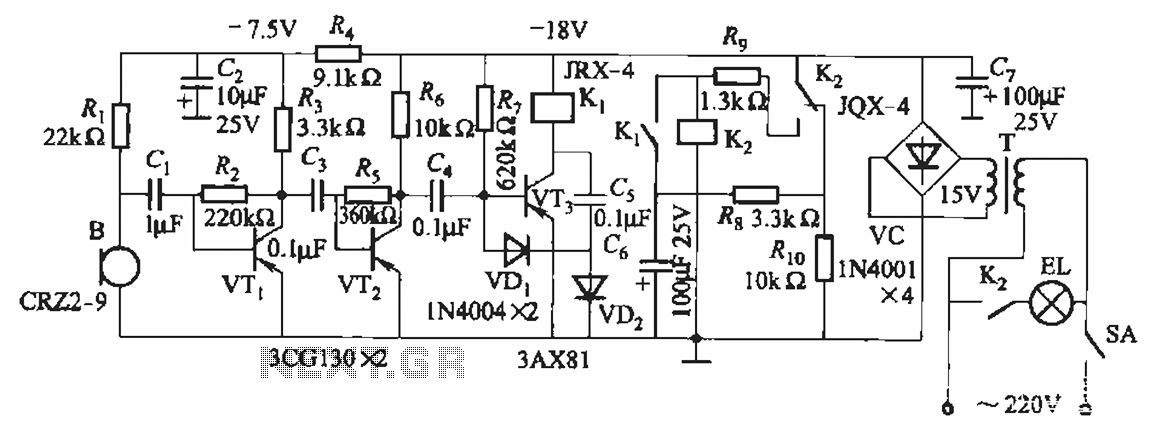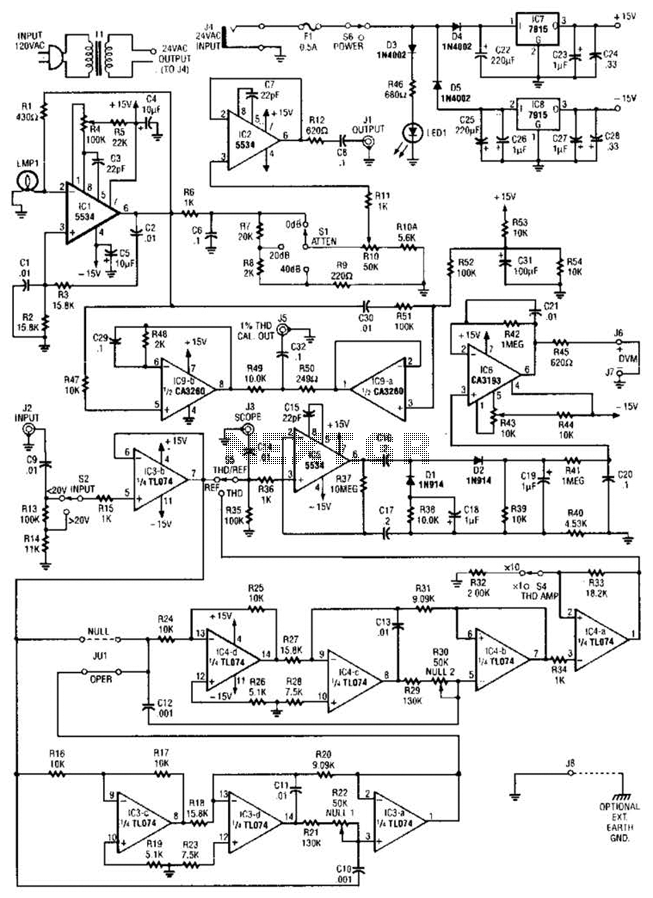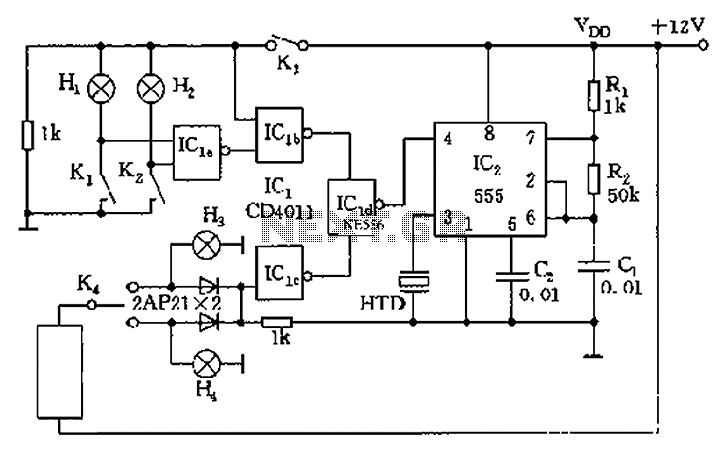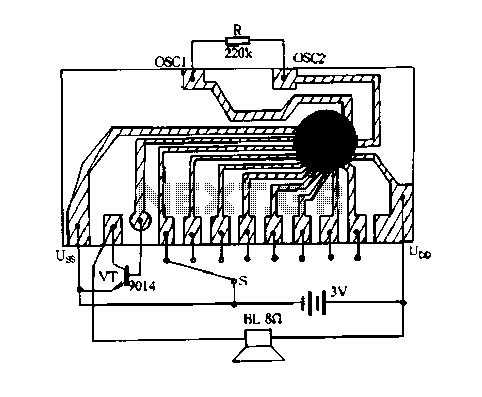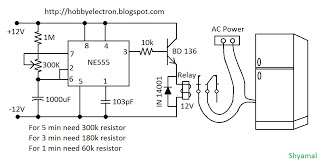
Interpolating Scanner Circuit
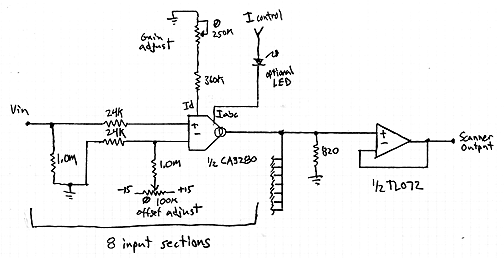
This design is for an interpolating scanner, a circuit featuring multiple signal inputs, a control voltage input, and a signal output. The output selectively transitions between inputs, smoothly fading from one to the next as the control voltage increases. A two-channel panner circuit can be viewed as a simplified version of a scanner. The data sheet for the Precision Monolithics, Inc. SSM-2024 current-controlled amplifier IC describes a stereo panner, referred to as an "Exponential Cross-Fade Controller," which utilizes two current-controlled amplifiers (CCAs) managed by a PNP differential amplifier. The circuit is straightforward, and similar circuits have likely been implemented previously. The presented circuit draws inspiration from JH's scanner but features a distinctive drive circuit that extrapolates from the differential amplifier topology used in the PMI panner. This design offers benefits such as maintaining a constant total drive current, ensuring that the sum of individual gains remains stable. The block diagram of the Interpolating Scanner illustrates that there is a traditional CCA for each signal input, each interfacing properly with the input signal, providing a current source output, and having a gain (transconductance) directly proportional to its control current input. The outputs of the CCAs are summed by directly connecting them. A buffer amplifier stage then adjusts the output level and impedance accordingly. The CCAs function as transconductance amplifiers, where the input is a voltage, the output is a current, and the gain is linearly proportional to the control current, which is anticipated to range from 0.0 to 2.0 mA. The op-amp in the schematic offers a flexible interface to external components, allowing for multiple inputs and manual controls, while slightly scaling the control voltage and supplying a low impedance source of the control voltage for the rest of the circuit. The challenge in extending a differential amplifier to more than two inputs lies in the need to gradually turn off one transistor while turning on another, and subsequently turning off that second transistor while turning on the next. Resistors R9 through R14 provide 190 mV voltage steps above the control voltage, while resistors R15 through R20 offer 190 mV voltage steps above ground. Diodes are used to select the higher of the two voltage values. The X-axis represents the voltage tapped off the op-amp in volts, and the Y-axis represents the various base voltages in volts. For clarity, the base voltages are shown before the base diodes, requiring an adjustment downward by one diode voltage drop to obtain the actual base voltages. The third plot illustrates the effect of the diodes, selecting the most positive voltage from each voltage pair. It is important to note that the extreme outputs are not paired, and the voltage between crossover points spans two voltage steps. The circuit allows for some control over the shape of the interpolation curve. Although the design is optimized for a smooth transition between stages, varying the control voltage swing and the difference between voltage steps can customize the curves. Three plots from a SPICE simulation of the scanner drive circuit depict the input control voltage on the X-axis (1 volt per division) and the individual output currents on the Y-axis (0.5 mA per division), with EIA colors representing output currents I1 through I8.
The interpolating scanner circuit operates by utilizing multiple current-controlled amplifiers (CCAs), where each CCA facilitates the processing of an individual signal input. The architecture allows for a seamless transition between inputs, enhancing audio mixing or signal routing applications. The design's reliance on a constant current source for the total drive current ensures stability in gain across all channels, which is crucial for maintaining audio fidelity during transitions.
The use of a differential amplifier topology in the drive circuit not only provides a robust control mechanism for the CCAs but also introduces versatility in handling various signal levels. By employing a buffer amplifier stage, the output can be adjusted to match the required impedance and voltage levels for downstream processing, thereby ensuring compatibility with other audio equipment.
The resistor network (R9 through R20) plays a pivotal role in creating the voltage steps necessary for controlling the CCAs. The diodes in the circuit are essential for selecting the appropriate voltage levels, ensuring that the most favorable signals are passed through to the outputs. This selection process contributes to the smooth fading effect that characterizes the interpolating scanner's performance.
Simulation results demonstrate the circuit's capability to produce predictable and controlled output currents in response to varying control voltages, confirming its effectiveness in practical applications. The ability to customize the interpolation curve further enhances the circuit's utility, making it suitable for a range of audio processing tasks, from simple panning to complex signal blending. Overall, the design leverages established principles in analog electronics while introducing innovations that improve performance and usability in real-world scenarios.This is an original design for an interpolating scanner, a circuit with a number of signal inputs, a control voltage input and a signal output. The output effectively selects between the inputs, fading from one to the next, as the control voltage rises.
A two-channel panner circuit might be considered a degenerate form of a scanner. The data sheet for the Precision Monolithics, Inc. SSM-2024 current-controlled amp IC shows a stereo panner, they call it an "Exponential Cross-Fade Controller", where two CCAs are controlled from a PNP differentialamp. The circuit is pretty straightforward and I`m sure similiar circuits have been used before. The circuit presented here is inspired by and similiar to JH`s scanner except that drive circuit is an unusual extrapolation of the differential amplifier topology used in the PMI panner.
This approach has some advantages: the total drive current (the sum of all the drive currents) is from a constant current source assuring that the sum of the individual gains is held constant Figure 1 below shows a block diagram of the Interpolating Scanner. There is a Current Controlled Amplifer (CCA) of traditional design for each signal input. Each CCA interfaces appropriately to the input signal, has a current source output, and a gain (transconductance) that is directly proportional to its control current input.
The CCA outputs are summed by shorting them directly together. A buffer amplifier stage provides the appropriate output level and impedance. The CCAs are transconductance amplifiers; the input is a voltage, the output is a current, the gain is linearly proportional to the control current, and in this case the control current is expected to be from 0. 0 to 2. 0 mA. More on this later. In the schematic above, the opamp provides a flexible interface to the outside world (you can add multiple inputs here as well as manual controls), scales the control voltage slightly, and supplies a low impedance source of the control voltage to the rest of the circuit.
The issue in extending a diff amp to more than two inputs is to not only gradually turn one transistor off and another on, but also turn that second one off and the next one on in the same manner. Resistors R9 through R14 provide 190mV voltage steps up from the control voltage and resistors R15 through R20 provide 190mV voltages steps up from ground.
The diodes select the higher of the two values. The X axis is the voltage tapped off of the opamp in volts and the Y axis is the various base voltages in volts. For clarity, the base voltages here are before the base diodes so offset everything down by one diode voltage drop to get the actual base voltages.
In the third plot we see the effect of the diodes, selecting the most positive of each of the voltage pairs. Again, for clarity this diagram shows voltages before the diode voltage drop. Note that the extreme outputs are not paired. Also note that the voltage between crossover points is two voltage steps. There is some control over the shape of the interpolation curve. The circuit presented above is optimized for a smooth and complete transition from one stage to the next, but by varying the control voltage swing and the difference between the voltage steps you can customize the curves.
Here are three plots from a SPICE simulation of the scanner drive circuit. All have the input control voltage on the X axis, 1 volt per division, and the individual output currents on the Y axis, 0. 5mA per division, with EIA colors representing output currents I1 through I8. 🔗 External reference
The interpolating scanner circuit operates by utilizing multiple current-controlled amplifiers (CCAs), where each CCA facilitates the processing of an individual signal input. The architecture allows for a seamless transition between inputs, enhancing audio mixing or signal routing applications. The design's reliance on a constant current source for the total drive current ensures stability in gain across all channels, which is crucial for maintaining audio fidelity during transitions.
The use of a differential amplifier topology in the drive circuit not only provides a robust control mechanism for the CCAs but also introduces versatility in handling various signal levels. By employing a buffer amplifier stage, the output can be adjusted to match the required impedance and voltage levels for downstream processing, thereby ensuring compatibility with other audio equipment.
The resistor network (R9 through R20) plays a pivotal role in creating the voltage steps necessary for controlling the CCAs. The diodes in the circuit are essential for selecting the appropriate voltage levels, ensuring that the most favorable signals are passed through to the outputs. This selection process contributes to the smooth fading effect that characterizes the interpolating scanner's performance.
Simulation results demonstrate the circuit's capability to produce predictable and controlled output currents in response to varying control voltages, confirming its effectiveness in practical applications. The ability to customize the interpolation curve further enhances the circuit's utility, making it suitable for a range of audio processing tasks, from simple panning to complex signal blending. Overall, the design leverages established principles in analog electronics while introducing innovations that improve performance and usability in real-world scenarios.This is an original design for an interpolating scanner, a circuit with a number of signal inputs, a control voltage input and a signal output. The output effectively selects between the inputs, fading from one to the next, as the control voltage rises.
A two-channel panner circuit might be considered a degenerate form of a scanner. The data sheet for the Precision Monolithics, Inc. SSM-2024 current-controlled amp IC shows a stereo panner, they call it an "Exponential Cross-Fade Controller", where two CCAs are controlled from a PNP differentialamp. The circuit is pretty straightforward and I`m sure similiar circuits have been used before. The circuit presented here is inspired by and similiar to JH`s scanner except that drive circuit is an unusual extrapolation of the differential amplifier topology used in the PMI panner.
This approach has some advantages: the total drive current (the sum of all the drive currents) is from a constant current source assuring that the sum of the individual gains is held constant Figure 1 below shows a block diagram of the Interpolating Scanner. There is a Current Controlled Amplifer (CCA) of traditional design for each signal input. Each CCA interfaces appropriately to the input signal, has a current source output, and a gain (transconductance) that is directly proportional to its control current input.
The CCA outputs are summed by shorting them directly together. A buffer amplifier stage provides the appropriate output level and impedance. The CCAs are transconductance amplifiers; the input is a voltage, the output is a current, the gain is linearly proportional to the control current, and in this case the control current is expected to be from 0. 0 to 2. 0 mA. More on this later. In the schematic above, the opamp provides a flexible interface to the outside world (you can add multiple inputs here as well as manual controls), scales the control voltage slightly, and supplies a low impedance source of the control voltage to the rest of the circuit.
The issue in extending a diff amp to more than two inputs is to not only gradually turn one transistor off and another on, but also turn that second one off and the next one on in the same manner. Resistors R9 through R14 provide 190mV voltage steps up from the control voltage and resistors R15 through R20 provide 190mV voltages steps up from ground.
The diodes select the higher of the two values. The X axis is the voltage tapped off of the opamp in volts and the Y axis is the various base voltages in volts. For clarity, the base voltages here are before the base diodes so offset everything down by one diode voltage drop to get the actual base voltages.
In the third plot we see the effect of the diodes, selecting the most positive of each of the voltage pairs. Again, for clarity this diagram shows voltages before the diode voltage drop. Note that the extreme outputs are not paired. Also note that the voltage between crossover points is two voltage steps. There is some control over the shape of the interpolation curve. The circuit presented above is optimized for a smooth and complete transition from one stage to the next, but by varying the control voltage swing and the difference between the voltage steps you can customize the curves.
Here are three plots from a SPICE simulation of the scanner drive circuit. All have the input control voltage on the X axis, 1 volt per division, and the individual output currents on the Y axis, 0. 5mA per division, with EIA colors representing output currents I1 through I8. 🔗 External reference
Warning: include(partials/cookie-banner.php): Failed to open stream: Permission denied in /var/www/html/nextgr/view-circuit.php on line 713
Warning: include(): Failed opening 'partials/cookie-banner.php' for inclusion (include_path='.:/usr/share/php') in /var/www/html/nextgr/view-circuit.php on line 713
